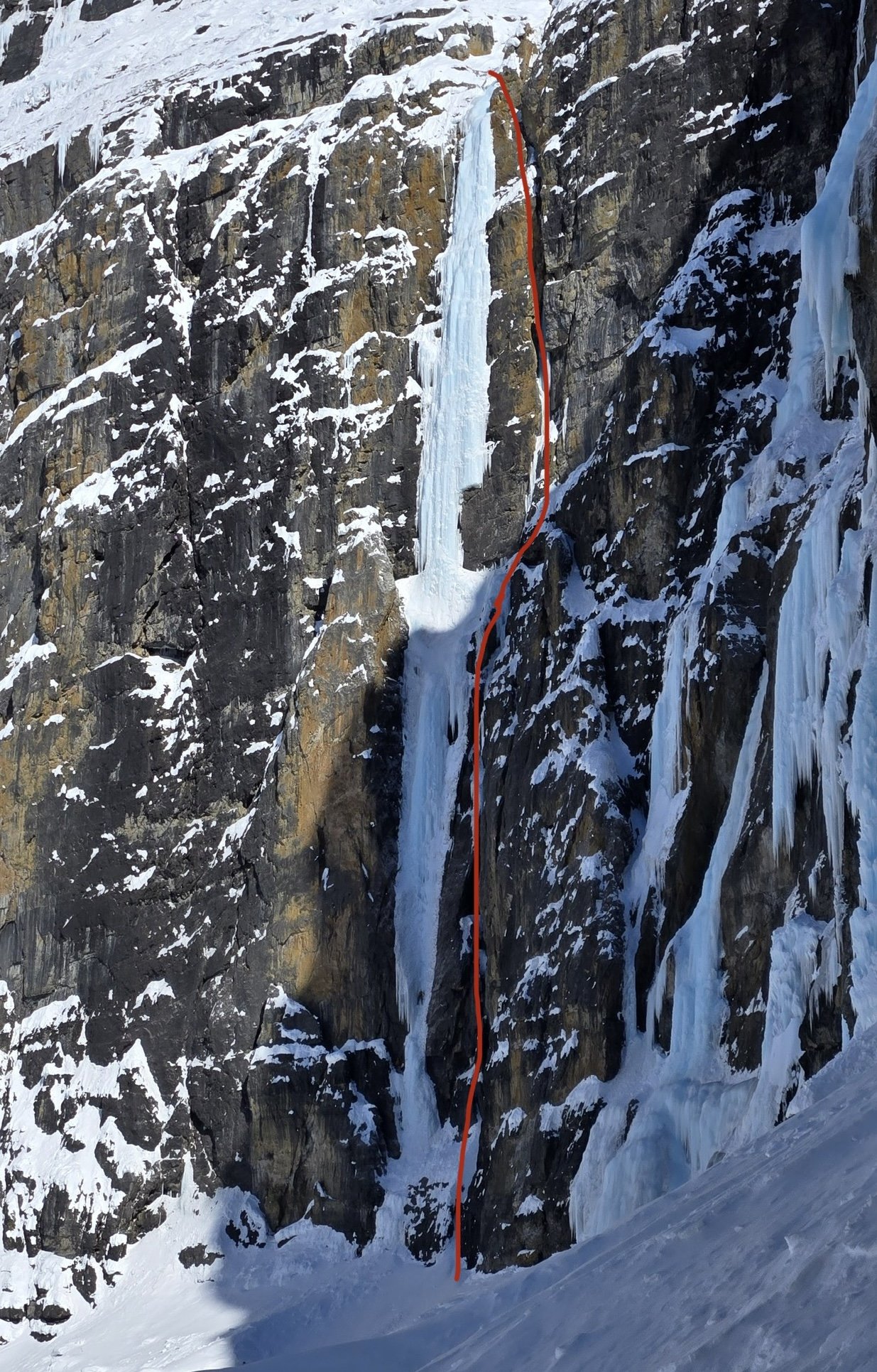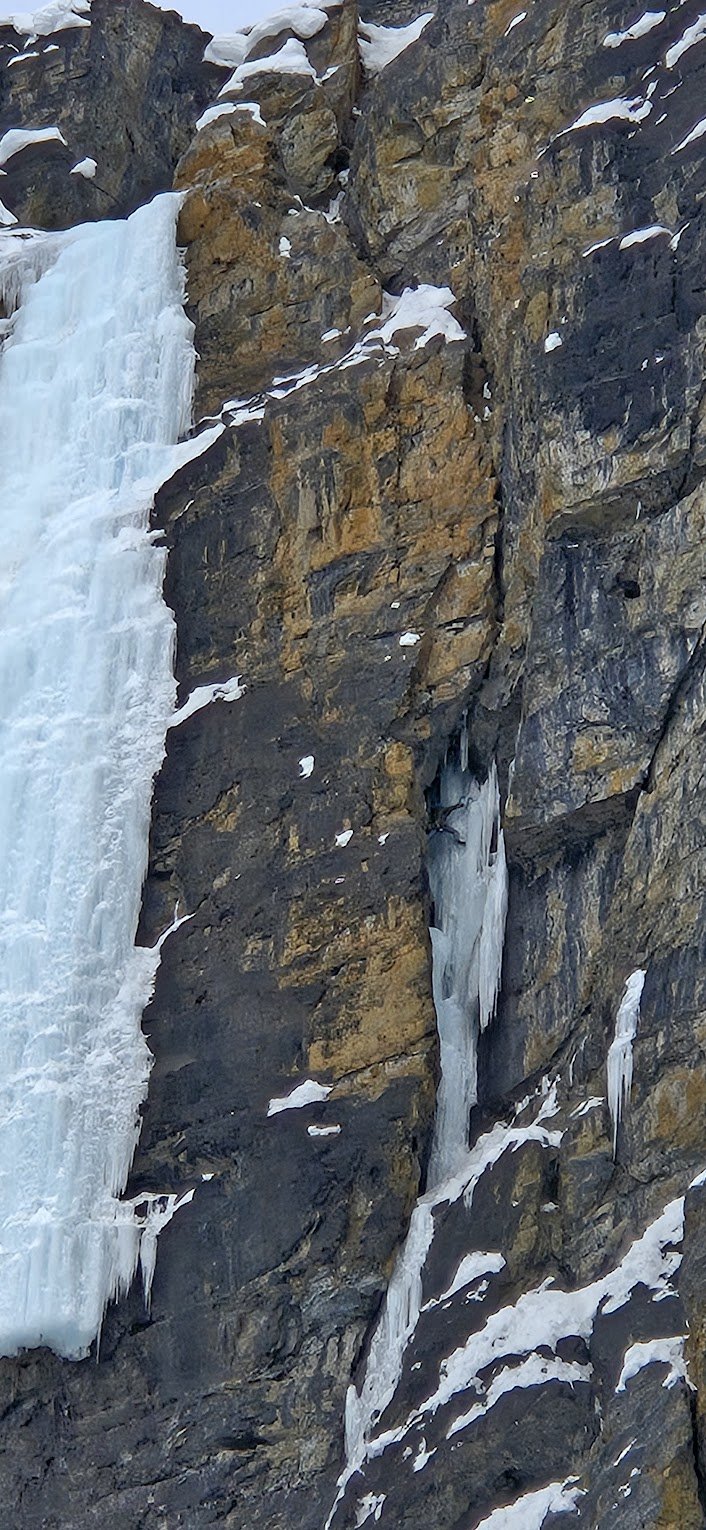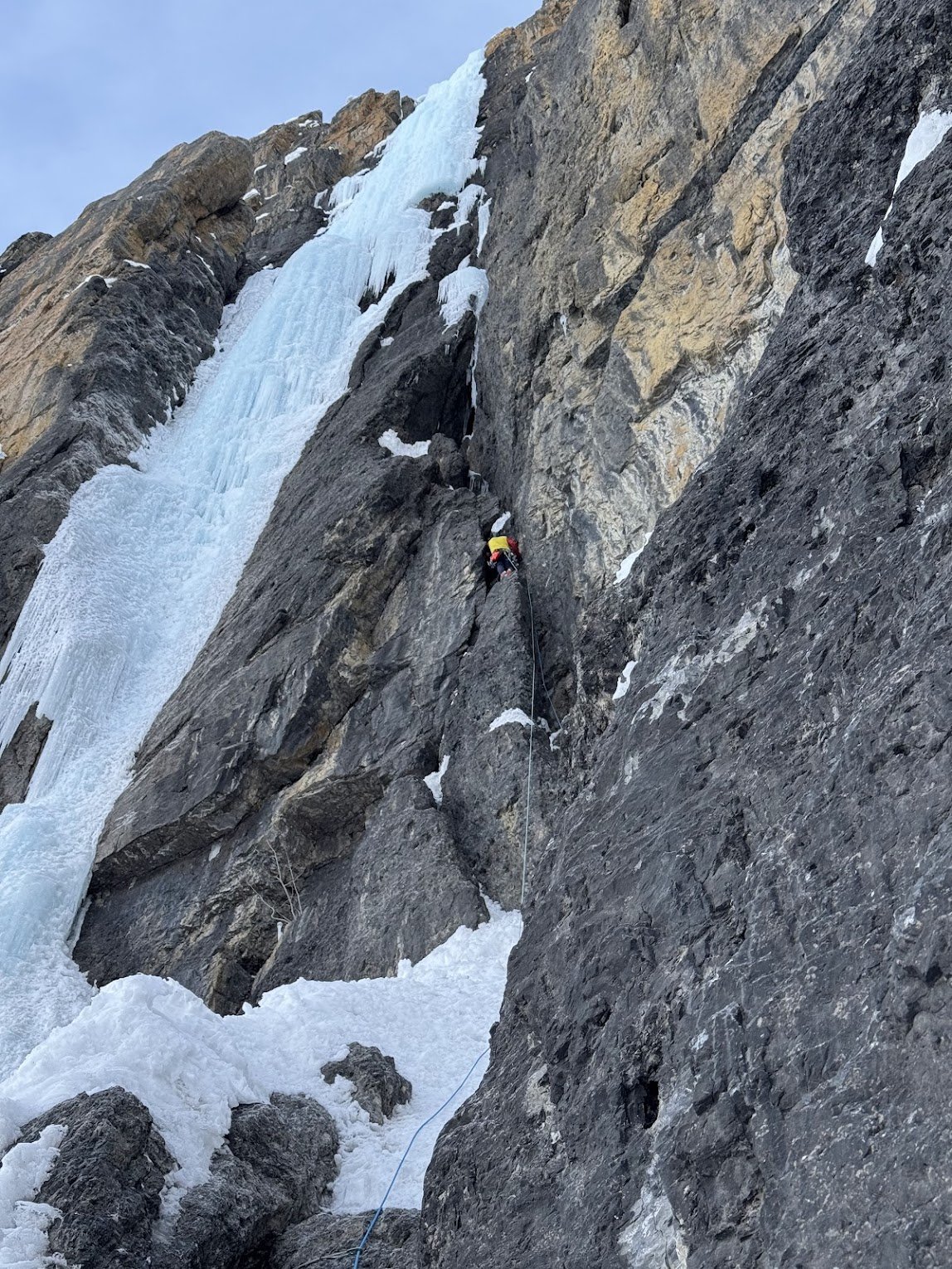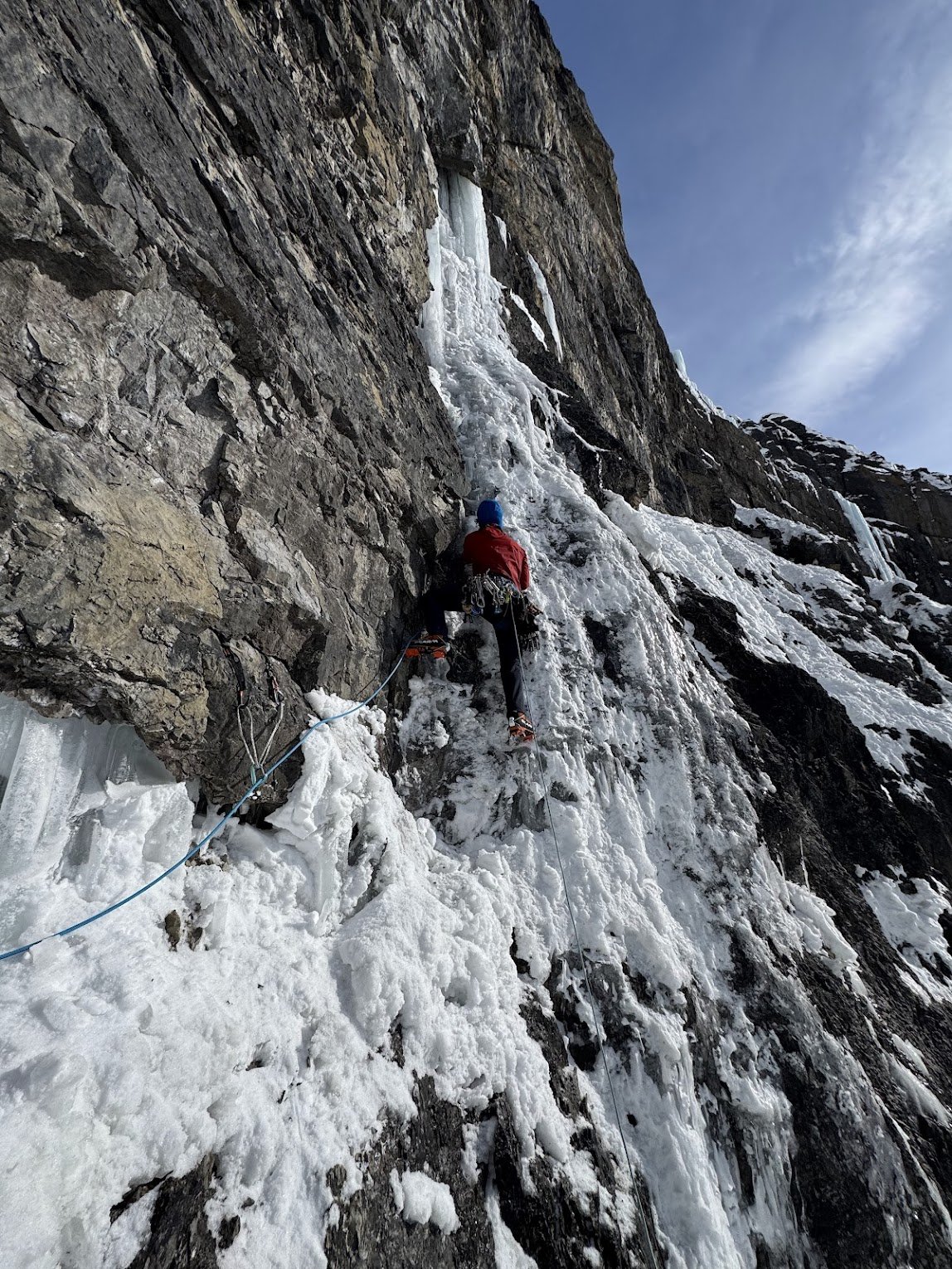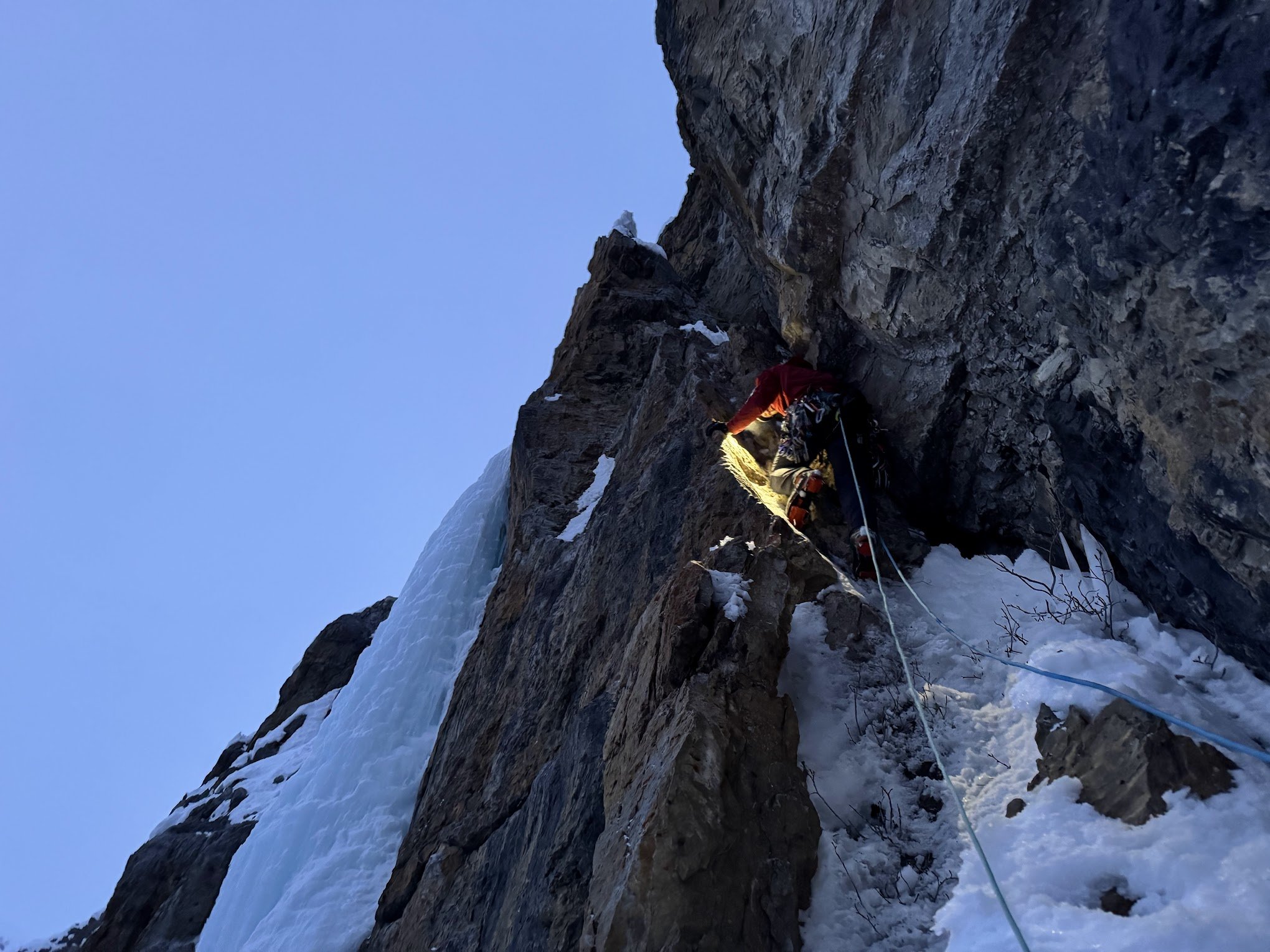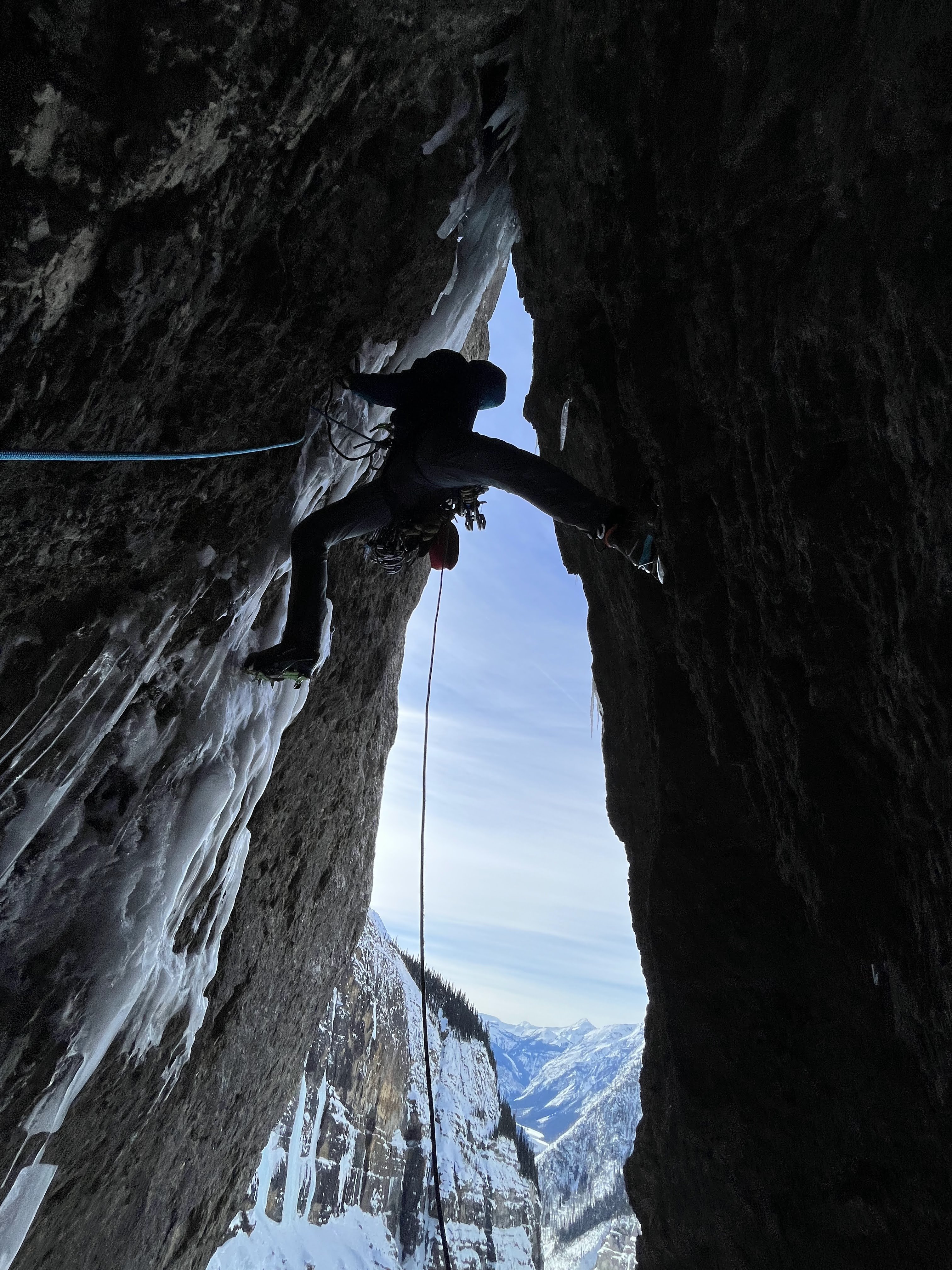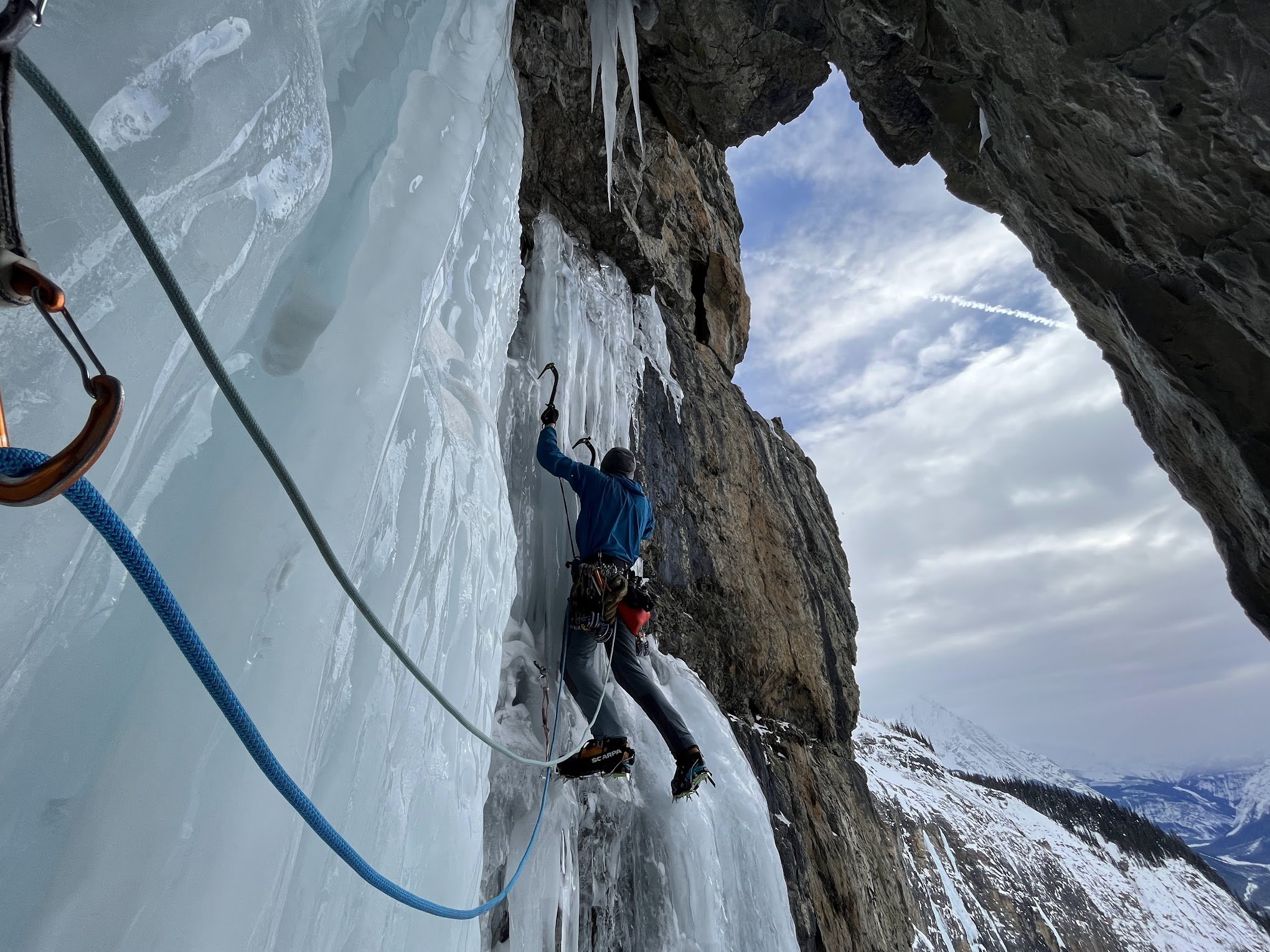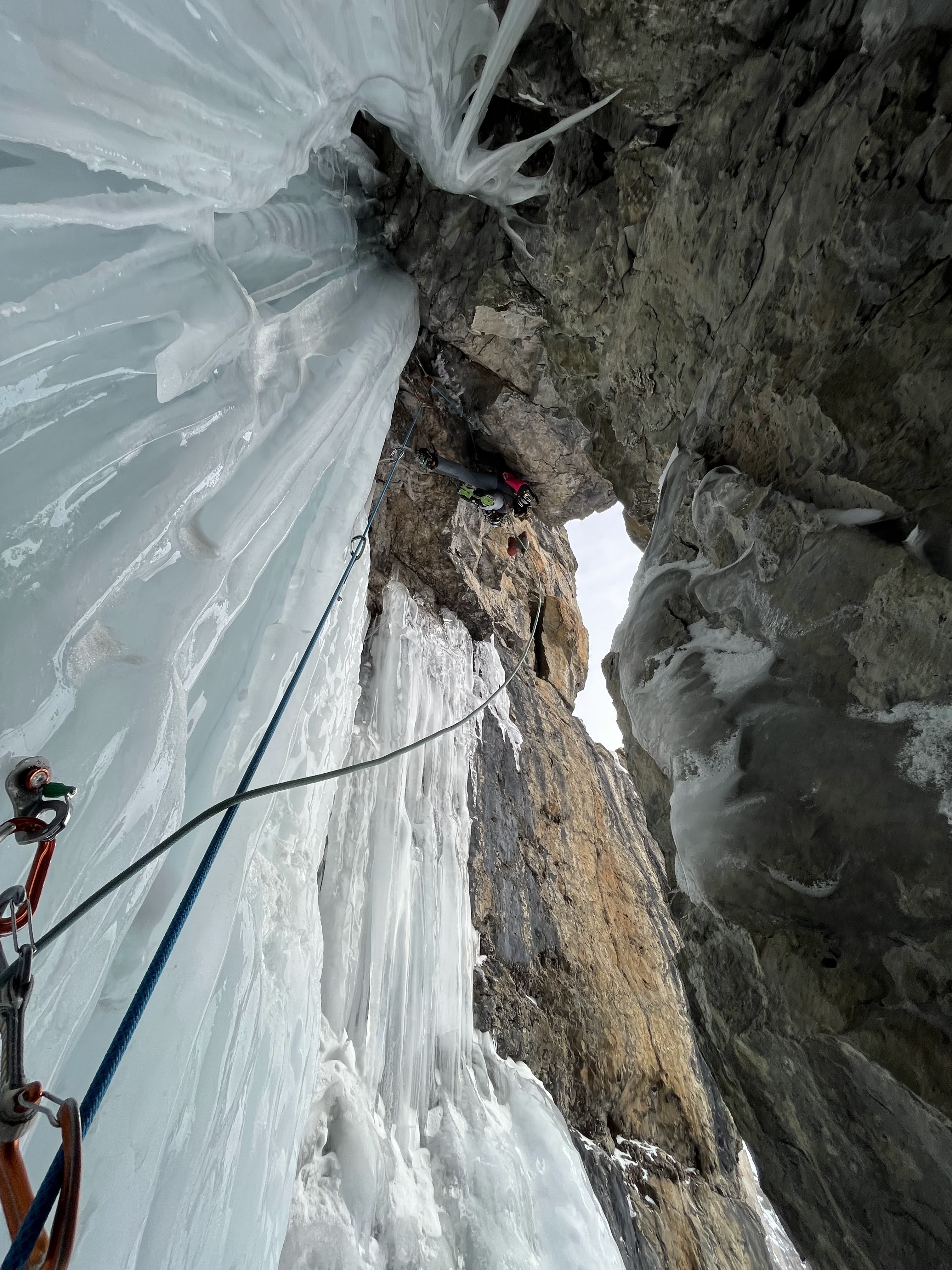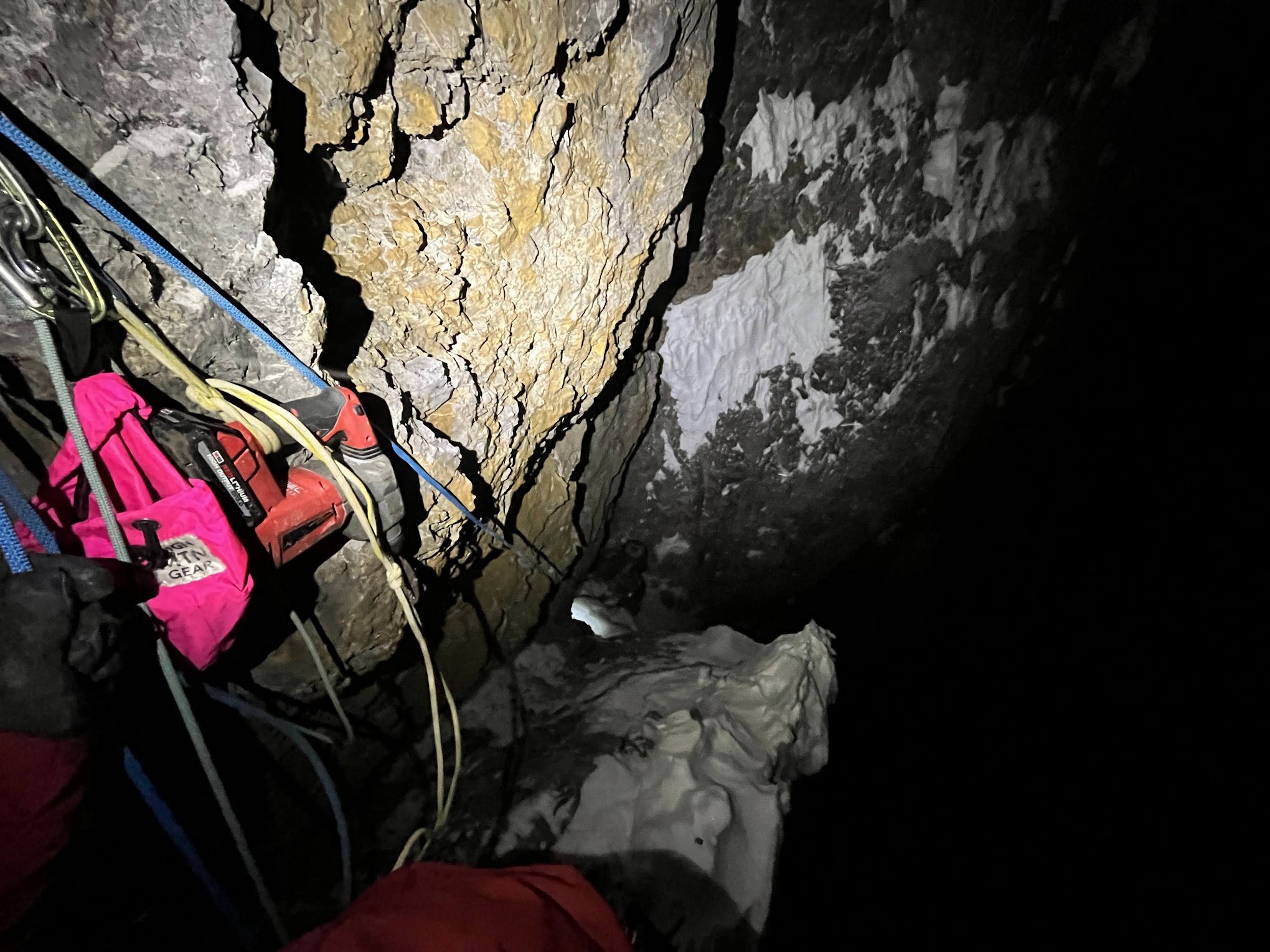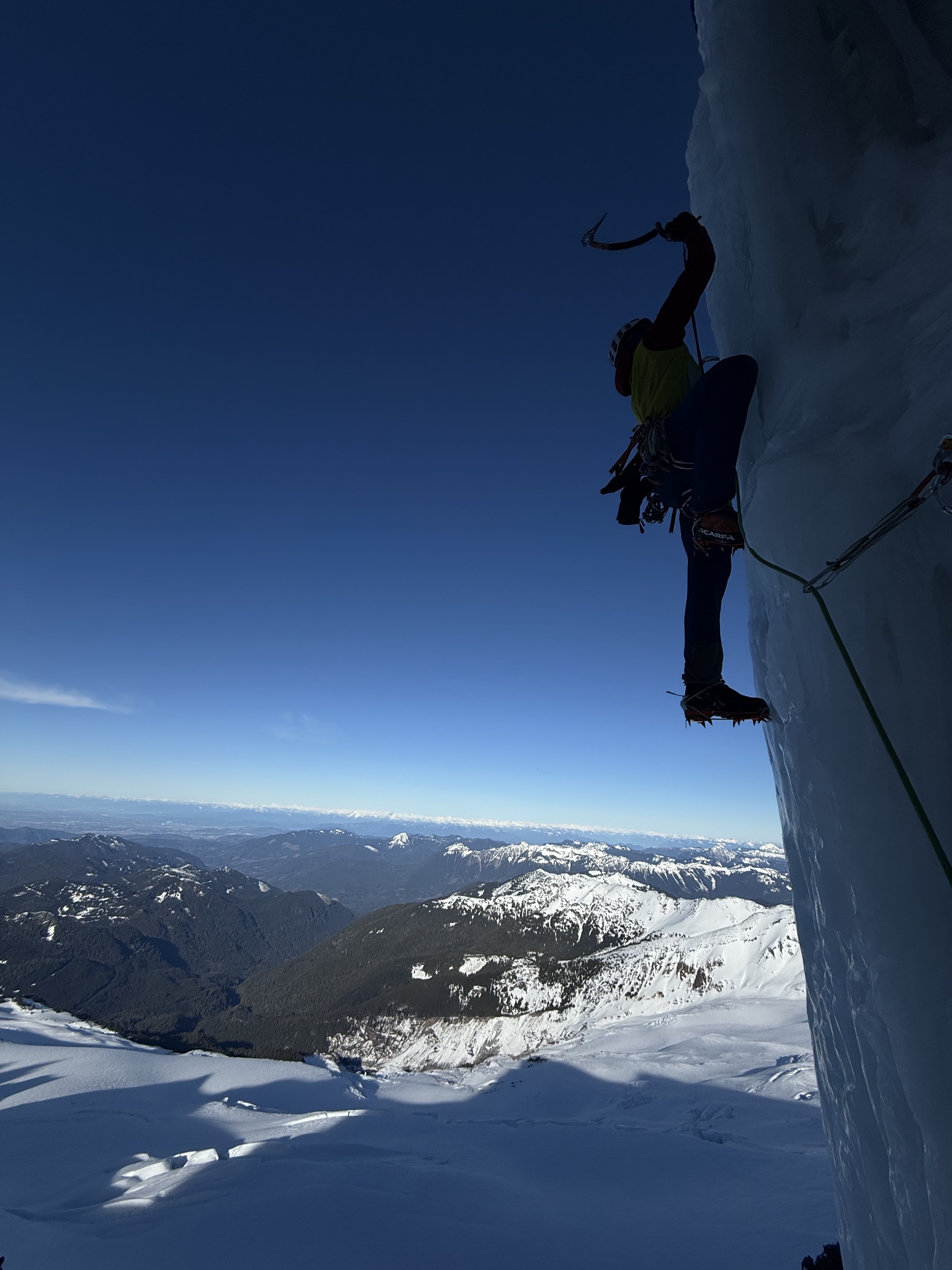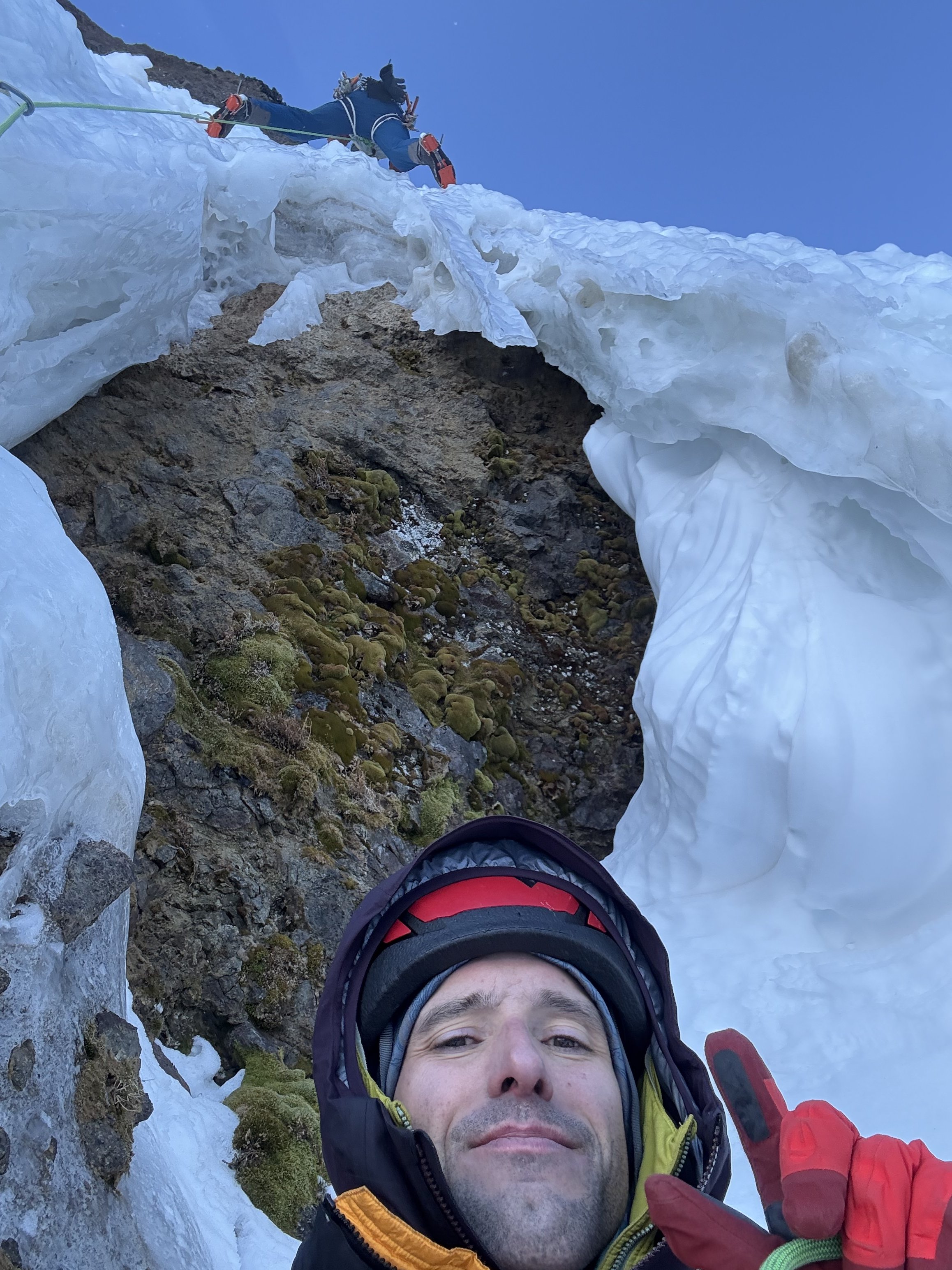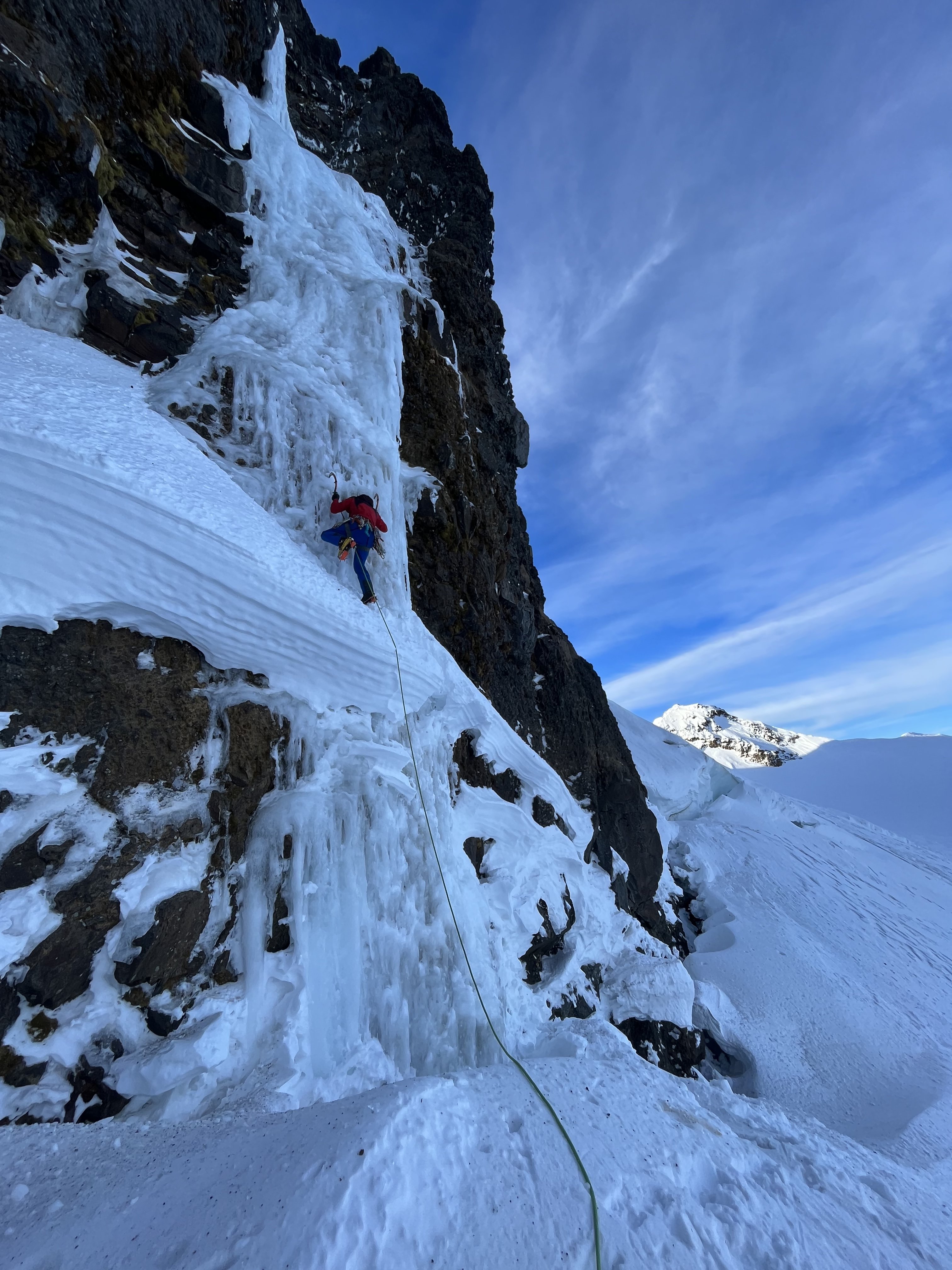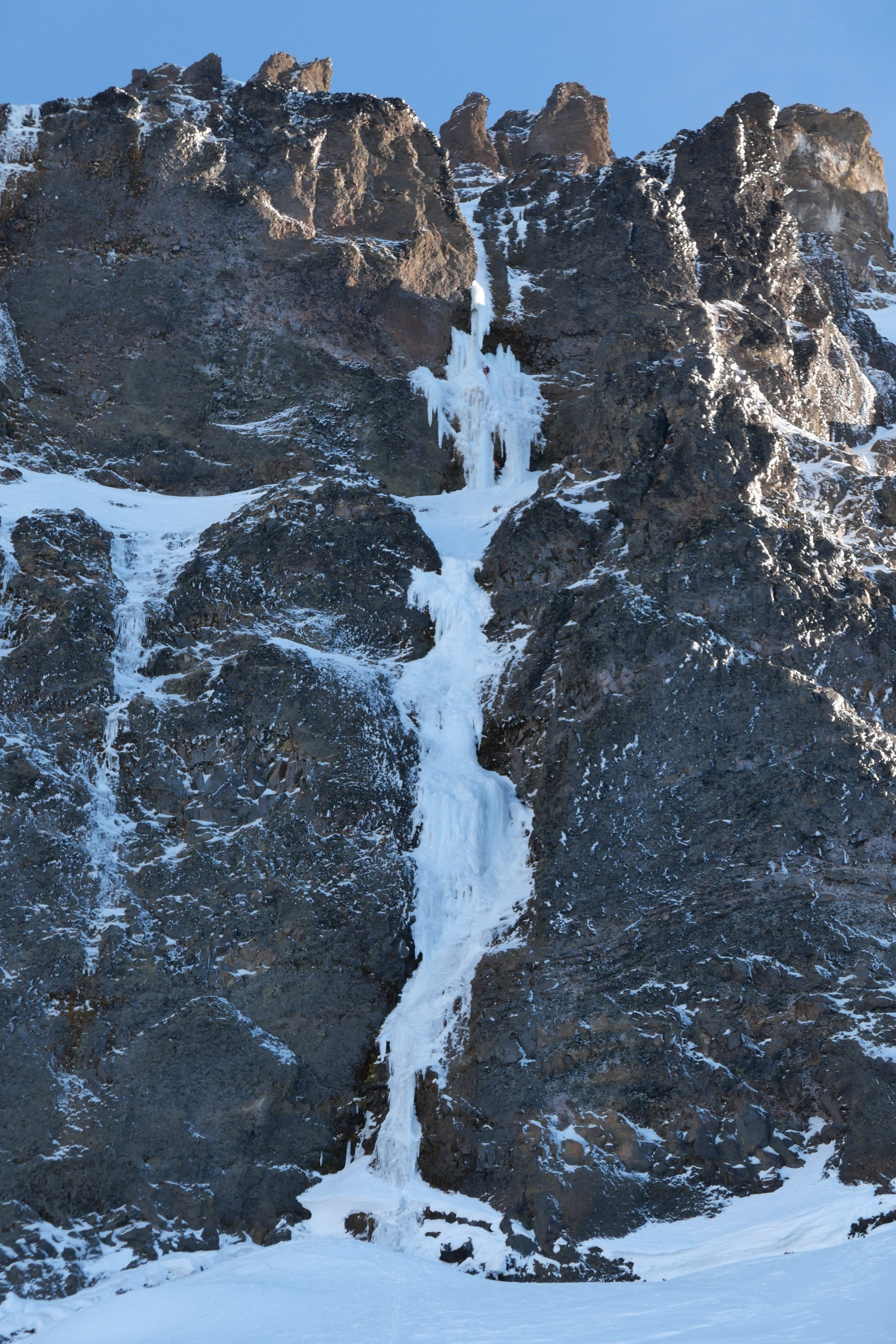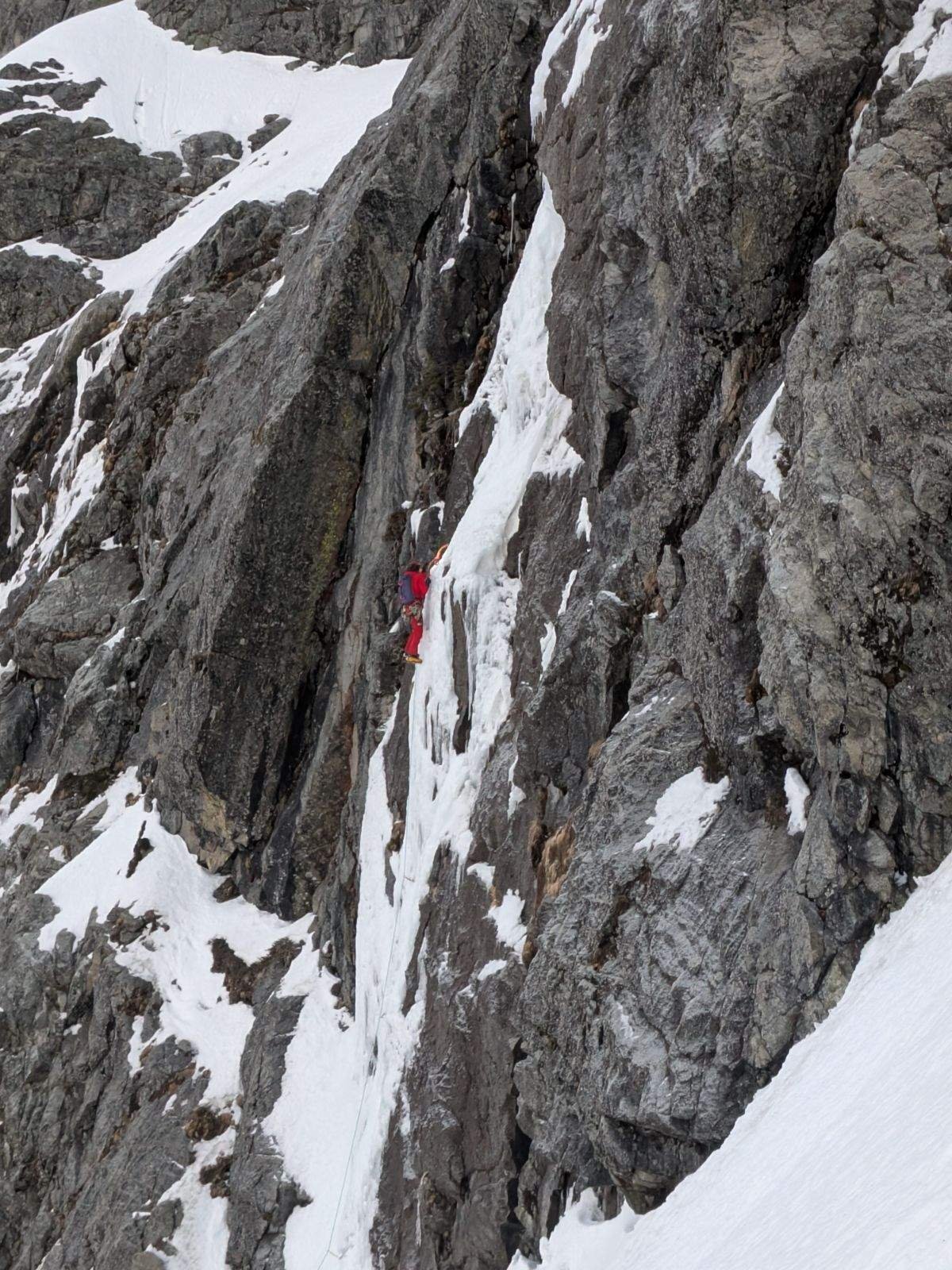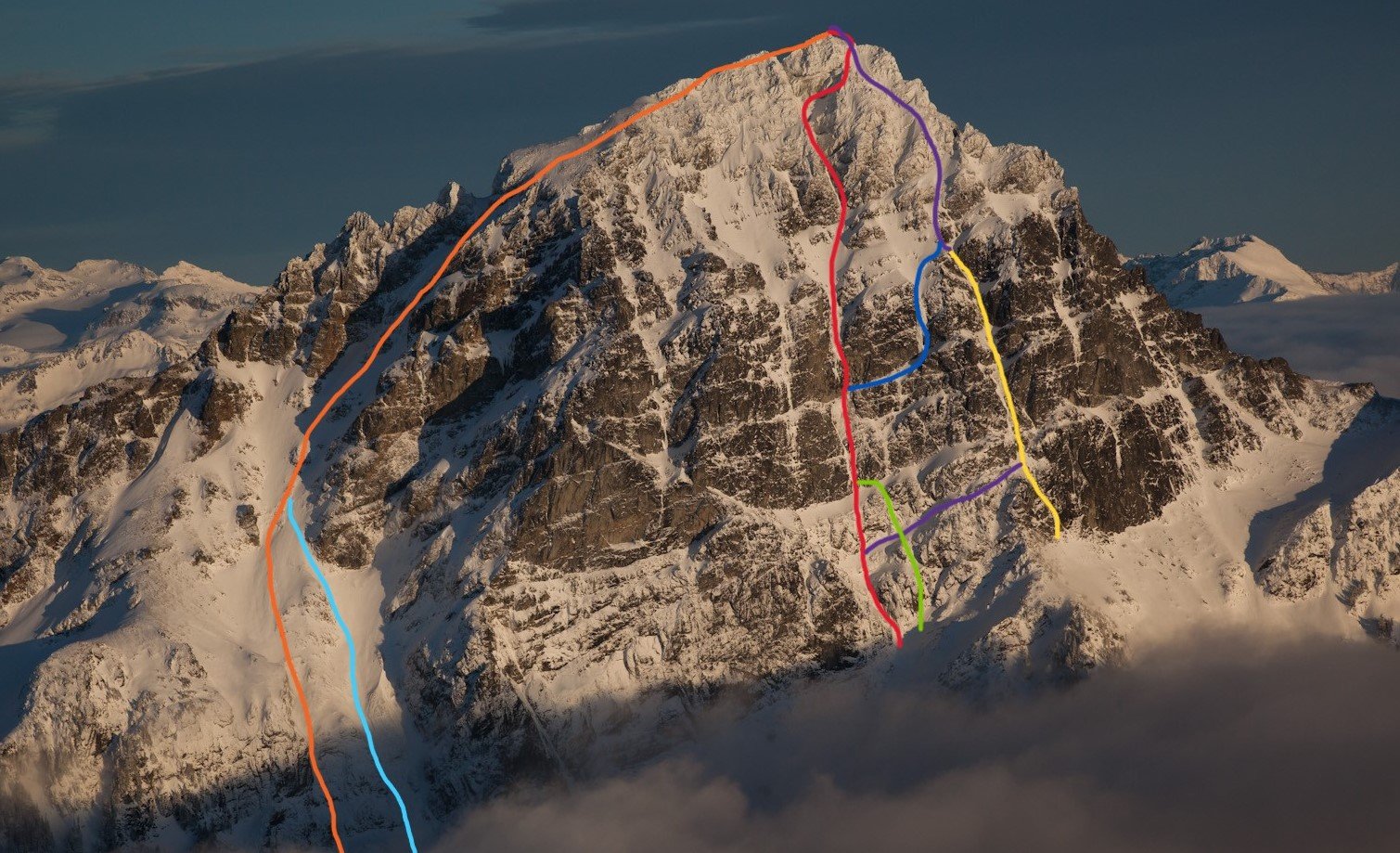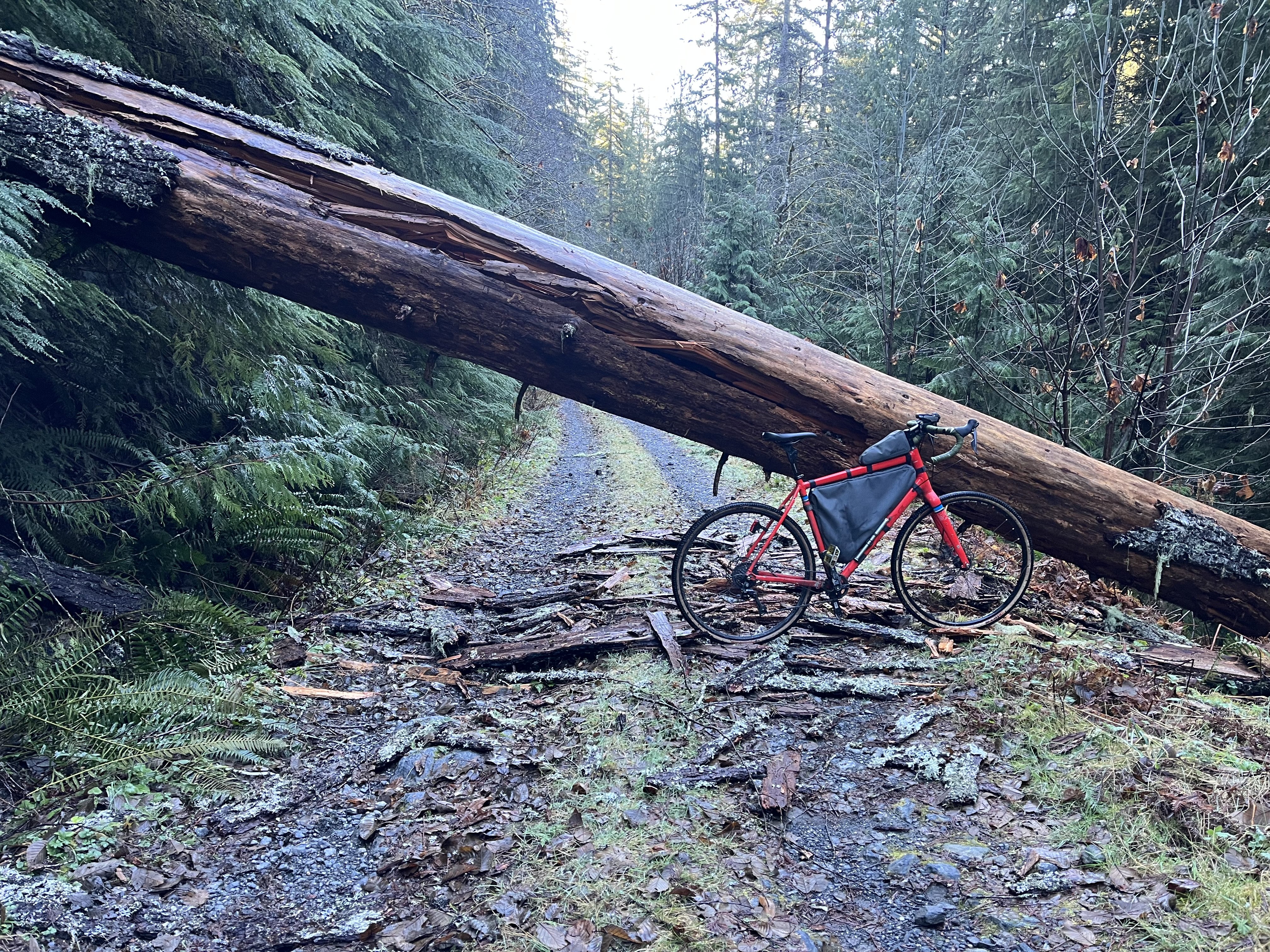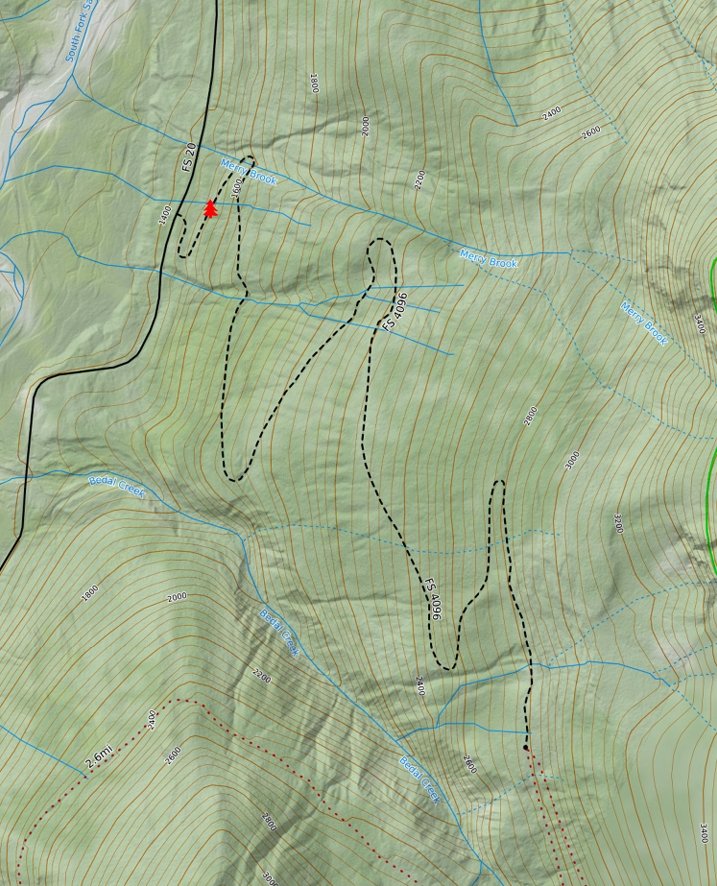-
Posts
135 -
Joined
-
Last visited
-
Days Won
51
Everything posted by Michael Telstad
-
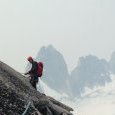
Southern Pickets Traverse attempt: 7/8-7/9/25
Michael Telstad replied to SMarj's topic in North Cascades
A classy traverse in even classier style. You spared yourself the worst choss by skipping Frenzelspitz. -

[TR] Forbidden Peak - NW Face 07/13/2025
Michael Telstad replied to Grant789's topic in North Cascades
Dream team ? -
I borrowed a copy from a friend several years ago and distinctly remember reference to several lines on that buttress. Regardless, It's great to see attention being paid to these lesser known features!
-
I just stumbled across a post on Facebook announcing that Alex Cunningham AKA @AlexC192 has passed away. I don't have any information whether it was climbing related or not. I don't think I ever met Alex, nor did I ever really interact with him online. Many of you have probably read his Yak Peak TR where lots of wise words of advice were given. It's sad to see some of our worst fears come true. Here is a Go Fund Me link that I came across if anyone wants to help his family.
-
Rumor has it that years ago while skiing the line, someone ripped an anchor in the runnels and stuck the landing into the couloir.
-
Last month a group of 7 friends and I went on a trip out to the remote Icefall Brook. An otherworldly cirque in the mountains north of Golden BC, housing likely the highest concentration of big ice routes in North America. While out there we climbed several of the classic ice lines and one new mixed route that we think was pretty classic. The new route we climbed parallels Fossen falls for five pitches up to M7 WI5+ with an A1 roof crux that we did not have time to try and free. It probably goes free somewhere around M8 or 9. Overlay of the route. You can see Doug near the bottom of Fossen falls for scale. P1: Our first pitch followed an obvious chimney system up into a cave below the beginning of a steep flare. Protection was decent, but the rock quality wasn’t the best. The cruxes consisted of a few bulge pulls with poor feet and decent snice sticks. P2: The second pitch was absolutely classic mixed climbing. The ice on the right wall was barely thick enough for good sticks, but stemming, chimneying and good rock gear eased the stress as the ice got steeper and fatter. A tunnel and a bunch more rock gear protected ice took us up to what is essentially the top of Fossen falls second pitch. P3: From here, I stepped out right and tiptoed my way up a barely-there smear aiming for a short but steep pillar above. Again, gear was hard to come by, but when I did find something it was usually good. More incredible ice and mixed took me to another protected comfortable belay stance in the back of the main cave. A scary, but spectacular pitch. Kurt said following it was one of the best pitches of mixed climbing he’s done. P4: Now under the crux, it was Kurt's moment to shine. He started by trying to climb some thin glassy ice out to the right in order to skirt the roof but backed off when the rock above looked downsloping, loose and generally really hard. Instead he opted to take the roof straight on, tagging up the drill and placing 3 bolts with a few pieces of intermittent gear. Once at the lip, he sent the drill back down and started free climbing again. As he climbed out of sight things got slow and quiet. Standing in my cave I watched rocks rain down into the abyss as a combination of snow and down plumes floated in the air from Kurt's shredded down jacket. Eventually he called off belay and I also aided my way through the roof to save time. The climbing above proved to be hard, grovely, runout and wide. The upper part of this pitch was bone dry and entirely chossy. A less classy crux than we had hoped for. The first attempt going out right that we backed off of. Kurt approaching the roof, I'm hiding in the back left corner. P5: One more pitch up a slick ramp took me up to a pedestal just above the top of Fossen falls. With no suitable cracks for an anchor, I hammered my tool into a deep pocket and tagged up the drill, drilling the only bolted anchor on the route. From there we rapped onto Fossen and took that the rest of the way down. Slogging down to the hut, we were welcomed by some cold dinner and the rest of our group already asleep upstairs. We called our route “Jumping for Joy” (M7 WI5+ A1). A phrase that Kurt's late father used often, for the simplest things in life. Rack: Double rack .2-4, handful of pins and ~10 screw including several stubbies. 2 70m ropes for rapping, but 60's are fine for the route.
-

[TR] Colfax Peak - The Polish Route 02/09/2025
Michael Telstad replied to tr0y's topic in North Cascades
I doubt the FS would, but the NPS absolutely has and will. There are certain bored NPS employees that love spending their time snooping YouTube looking for infractions. Maybe think twice before posting that sick video of you paragliding off Mt. Shuksan. -

first ascent Sloan Peak - [FA] Borrowed Time (WI5 M7)
Michael Telstad replied to Michael Telstad's topic in North Cascades
Oh damn. I heard super 3rd hand it was a party attempting Superalpine. However that is most definitely the base of our second pitch. Glad they had good weather and were able to get flown out of there. There’s a video now LINK -
The people want to see the Nooksack report! You might not qualify, but you should try reaching out to Mark Smiley about getting some cash for those pickets. He sometimes reimburses young climbers a percentage of their bail anchors to discourage rapping off shit gear to save money. ANCHORS LINK
-
So many thanks to you @olyclimber. When the CC landing page turned into a virus riddled porn ad I was fearing the worst. If the day does come that the site has to die (god forbid), all I ask is that we try our best to get it archived like SuperTopo. The amount of history and beta here is invaluable.
-
- 27 replies
-
- 12
-

-

-

-

-

first ascent Sloan Peak - [FA] Borrowed Time (WI5 M7)
Michael Telstad replied to Michael Telstad's topic in North Cascades
Shhhhh ? Honestly I would be so happy to see someone else fill in another line. -

first ascent Sloan Peak - [FA] Borrowed Time (WI5 M7)
Michael Telstad replied to Michael Telstad's topic in North Cascades
Probably WI4 for the pitch, but after 20ft of steep traversing it was all over. -
I think at this point we have established that the SP is not the superior lead rope solo device. People are climbing 5.14 on grigris with minor modifications. I know of several folks who have both, and choose to use the grigri instead. It’s time to let the silent partner die in peace.
- 1 reply
-
- 1
-

-

first ascent Sloan Peak - [FA] Borrowed Time (WI5 M7)
Michael Telstad posted a topic in North Cascades
The often-discussed west face of Sloan has been in the forefront of my mind for about as long as I've been winter climbing. When I first came across the stunning Scurlock photos of the face, I was blown away to learn that there had been no successful ascents of any of the major ice lines. Rumors of poor-quality ice came with every attempt up until Kyle and Porter's climb in 2020. I'm not going to lie, I was somewhat disappointed when I heard someone got to it first, but it was only a matter of time. A few weekends later I skied in with @sfuji to try and take their route to the summit. Weather changed rapidly and we spent the night in the basin listening to avalanches rip down the face as it continued to snow. We skied out the next day after some consolation pow turns. My attention then turned to the prouder lines on the main face. Still not yet entirely sure I was ready for the direct line, I set my eyes on what would become the Slither (Merrill-Minton). When that high pressure system hit in late Jan 2023, I knew it was the perfect window for the face but had committed to some other obligations. When I got a text from Tucker asking if I thought their line was previously unclimbed, I felt that same pang of disappointment mixed with the psyche for my friends. It had taken a while, but the plums were slowly getting picked. At this point I knew I had to make this a priority, If the window showed up, I had to at least try. In the summer of 2023, I went out and climbed the SW face rock route Fire on the Mountain. It was my first time actually touching the peak, and I was impressed by the rock quality. This gave me hope that the pitch up to the dagger would be possible but might need a few bolts. It also gave me the opportunity to experience the upper mountain and SE shelf descent. Fast forward to about two weeks ago when this massive high pressure system rolled into the forecast. A brief but deep warmup followed by a long stretch of cold high pressure. THIS was the system I'd been waiting for. Bozeman and Patagonia had stolen the majority of my go-to alpine partners for the winter, so I quickly exhausted my list of regulars. I began reaching out to friends of friends who I'd never climbed with before but seemed up to the task. Finally, I convinced Justin Sackett, a guide based in Portland to make the drive up for the weekend. On Wednesday the 15th I woke up in my car along the Mountain Loop and began pushing my bike up the Bedal creek road. At the time, there was a large tree fallen over the road that was impassible in a car, not that my Prius would have made it much further. I hiked in with a tag line, some pins and a small hand drill bolt kit to stash below the face. Along the way I cleared some branches and did my best to establish an easy to follow boot pack. It also confirmed that skis would not be worthwhile to bring. I snapped some photos through my binoculars and booked it back down trying to get a few hours of work in that afternoon. Scoping the dagger. The Slither is also fat for anyone keen on taking this one to the summit. That day I posted trying to get someone to go chop down that tree, and to my surprise @Manheartmountain was already on his way out there to do the work. This saved us about an hour on either side of the day, and a good bit of suffering. Our alarms blared at 2:40 am on Sunday, early enough that my body hadn't quite realized I was sleeping. We crawled out of the car and set off a little after 3am. The Redbull, gas station muffin and last night's Chipotle fought for dominance in my stomach. The approach went smoothly with the refrozen snow surface, and we found ourselves in the basin around 5. Here we ran into Rob who was planning to make a solo attempt on Superalpine. We shared trail breaking duty up into the lower gulley of the face. Below the first ice step we stomped out a platform and pulled the rope out, after taking a short break Rob continued out right across the ledge towards the Superalpine gulley. Described as WI3 in Tuckers Slither report, our first pitch involved a heinous aerated delaminating pitch of WI5. This was by far the hardest pitch of ice we climbed. It can be bypassed by walking around to the left, or possibly the ramp to the right climbed by @Marcus Russi on his 2017 attempt. It also looks like a good pitch of M5-6 climbs just parallel to our ice smear connecting at the top where the ice is better. Lots of options here, we don't really recommend climbing the same pitch as us in the conditions we found. Photo courtesy of soloist Rob. Justin on the first pitch. Deceivingly steep. The rock on the left looks very climbable, or you can just walk around. I took over for the second pitch and found the start of this pitch to also be aerated shampoo ice at the very bottom. I placed a beak and made a few rock moves to establish on the good ice a few feet up. From there a WI4 groove took me to the top of this step where I made a good screw anchor. The aforementioned beak was unable to be cleaned so it's still in place. I'd like it back if anyone else goes up there soon. Another pitch of harder than reported ice, either we had more different conditions or Tucker is a sandbagger. Likely the latter. Looking up at P2. Once again, we swapped and Justin Lead a pitch of WI3 up through a groove and out onto the onion skin cone below the dagger. Not a whole lot in terms of pro here, but incredible one swing hero ice for the follower. Now below the dagger, we took a short break and got prepared for battle. When racking up in the basin I chose to leave the bolt kit behind. This route deserved an honest attempt on natural gear before being sieged. After traversing back and forth a few times I finally chose my line and started climbing. The rock on this portion of the wall is highly featured, but extremely compact. Due to it being wet so much of the year, every crack and seam was full of frozen moss. This made climbing easier in some ways, but finding decent protection a real challenge. I slowly picked my way up, getting gear wherever I could. The terrain was pulling me right, but I eventually needed to cut back left to access the ice. Once a decent option showed itself, I made a hard traverse towards a hanging face under a roof. Finally getting a piece I was really happy with, I plugged in an additional garbage cam for good measure and committed to the steep footless traverse under the roof where I got myself a bit overcommitted. With my last pieces below my feet, and an arm wrapped around a small spike, I made a last ditch effort to press onto and sit on the thing the best I could. Barely getting enough of my mass onto this perch to go hands free, I pounded a KB into a seam right in front of my face. Finally able to relax a little bit, I knew that if I could keep it together just a little longer, I'd be on the ice and home free with the onsight and both my ankles intact. The final traverse went smoothly and I made it into the belay cave just before the sun peeked around the corner. In the warmth of the sun, I was able to revel in what I had just accomplished while Justin followed the pitch clean, securing our team onsight. The Beartooth Alpine picks still climbing ice well after a long game of "turf or rock" The gloves had to come off for this one. Unbelievably psyched. Also the point I realized I forgot sunscreen. The actual dagger ice pitch ended up being quite moderate. A steep traverse on fantastic quality ice took me to a WI3 ramp. If your biceps aren't cramping by that point, a stunning direct pitch of WI5 can be taken instead. It looks like in some years, a tunnel forms behind the pillar allowing for you to cut through, instead of around to access the easier climbing. From there we unroped and slogged up the snow slope up into the major corner at the top of the face. The occasional step of easy ice, and some snow offwidth climbing in a runnel took us most of the way up this feature. Near the top, the corner chokes down to a squeeze chimney directly up to the ridge, or you can cut right up easy snow and scrambling to gain the summit from the south ridge. I started up the chimney dreaming of the super direct but was turned back by BS sugar snow caking one side of the chimney. A fun challenge any other time than now, I backtracked and opted for the path of least resistance. We arrived on the summit at 3:45. Mooses Tooth or Sloan? We started down the corkscrew a few minutes later, and finally had the sun set on us near the bottom of the SE shelf. The diagonal steep snow downclimbing seemed to drag on forever, but we eventually made it down to walking terrain and slogged our way back around the mountain. We got back to the trailhead at around 8:20. Back at the car. Rack: 8-10 screws, handful of KB's, beaks and at least one small angle. Nuts, Single rack .1-2 (doubles would have relieved some stress). 60m rope & tagline was great for hauling the packs on the crux pitch. All the winter routes and variations I know about Photo credit: John Scurlock Orange: Full Moon Fever (AI4R, 5.8, 50deg) Crux pitches out of view Light Blue: NW face ski line Red: Borrowed Time (WI5 M7) Green: 2017 attempt Blue: Merrell-Minton AKA Sloan Slither (WI4) (AAJ) (CCTR) reportedly a sandbag by Aaron. Yellow: Superalpine FA w/out summit Purple: Superalpine with summit and better access ramp Not Drawn: Corkscrew route & Ryan Hoover's attempt to just below dagger.- 19 replies
-
- 16
-

-

-

-

-
Holy shit. Polish hadn’t even crossed my mind. Any pictures of Kimchi Suicide?
-
There's currently a large tree fallen over the road up to the Bedal creek trailhead. It's currently the only obstacle blocking the whole road and is unfortunately near the very bottom. If there's anyone who enjoys this sort of work, I'd be more than happy to buy you a six pack of your favorite beer in exchange. I'm heading back up there on Sunday and would love to be able to drive all the way up to the trailhead, instead of walking that damn road again. I talked to some guys on the drive out and they said they would go take a look and clear it if they could. I don't particularly want to rely on them, so if anyone goes out there and it's already gone, I'm still happy to send some beer your way. Below are photos of the tree and where it is on the road.
-
I totally forgot about this ?. Sorry oly but I think I'm set now. Hope you find a buyer.
-
I’ve had little to no motivation for TR writing this last year, but figured I should try and get this story out into the world before I forget some of the fun details. Last April Eli Spitulnik and I flew onto the Ruth Glacier with about five weeks of food. We hoped to stay there until it warmed up, then bump to the Tokositna to do some climbing on Huntington. We got deposited right next to a very cold and dejected Brit and Slovene. The winter cold was still holding on strong, with nightly winds burying our camps regardless of how recently it snowed. Tom and Gasper had been there for about a week already and spun tales of vertical sugar snow and towering snow mushrooms. Their attempts on Blood from the Stone, and the direct start to RGG were valiant, but fruitless. Huge thanks to basecamp gear sponsor Kurt Ross. Chamonix style storm day skiing with Tom and Gasper. Who needs a pack anyways? Scouting. After almost two weeks and various attempts on other routes, we began skiing towards the SE face of Bradley at about 3 in the afternoon. Along for the ride was 3 days of food and a rack suitable for El Cap. Our intended line would start on Vitalogy (Zimmerman/Allen 2010) to gain the hanging snowfield in the middle of the face. Once there, we would climb more or less straight up the center of the face intending to finish in a couloir that would take us to the summit ridge. Day 1.) Following the same night climbing method as Graham and Mark, we hung out below the face as it went into the shade. Watching and listening as it calmed down for the night. Once things fell quiet, we began up the approach ramp. At the end of the ramp was a cave guarded by a 25ft tall overhanging mushroom. Still in simul mode, I fiddled in a small nest of gear and began pulling some steep mixed moves to surpass the overhanging portion of the shroom. From off to the side and around a corner 60m away, Eli heard a faint “watch me!” as I hung my pack off a beak and committed out onto the face of the shroom. Kicking myself for leaving the picket at camp, I beat the mushroom into submission until I was able to flop over and into the cave. Downclimbing from a gear cache on an early "false start". The weather changed and we decided to retrieve our rack the next morning and pivot to a different objective. The start ramp continues out left. Eli mantles onto my pack before stepping out right onto the mushroom. The next few pitches were some of the most brilliant mixed climbing I’ve done outside of a crag setting. A perfectly splitter slightly overhanging #4 crack, and short pendulum took us out towards the lip of the cave, where ice blobs allowed for an easy exit. A pitch of junky slush and a short traverse (dubbed M5R in the Vitalogy topo) took us to the M6 turf flakes pitch. A wonderfully long series of dirt filled grooves and flakes just frozen enough to get good sticks. By the time Eli made it up to the belay it was officially dark. Eli pulled on his rock shoes and took the lead. He took us out right up a well protected corner that gained a pillar, then up and right out into the slabs below the snowfield. Following in my crampons, I scratched my way up to the most heinous hanging belay. Balancing on crystals in my mono points I belayed as Eli swapped back into boots and began a long extremely runout traverse crossing fingers of barely refrozen snow over slab to gain the snowfield. Desperately sliding out of glassy fists. Delicious blobs Glorious turf At one point while readjusting to keep my legs from falling asleep I turned around to see the sky erupting in green and purple stripes. I shouted into the darkness to look at the sky. A distant hoot followed a moment later and I began lowering out the bags. The rest of the night was a blur of unprotected wallowing up crusty sun-baked facets in an attempt to reach the prow bivy before sunrise. Staring at the rope snake off into the darkness I weighed my options of preparing to unclip in the event of a fall, or try and catch a 120m whip. We arrived at the bivy just before sunrise. My perception of time is beginning to slip. Day 2 After a restless few hours festering in the tent listening to wet slides, we began prepping for another night of climbing. This time we would be leaving behind the comfort of previously traveled terrain and entering an unknown world. Bailing from above the snowfield while likely not impossible, would have been a bad time. More sparsely protected snow climbing took us up to a flared and wet crack feature that Eli dispatched fairly easily in his rock shoes. From there a few pitches of engaging mixed climbing took us to what I expected to be the crux of the route. From photos, a large snow plastered double corner system seemed to be the most obvious way, but it would likely involve some gross aid climbing tactics. We arrived below the feature in fading light as night two began. It looked so much worse up close than from afar. In a last-ditch effort to find an alternative, I traversed left looking for anything else. As I swam my way around the corner, a pillar revealed itself with a perfect wide crack and thin seam alongside it. It didn’t entirely look like it went all the way, but it was a good next step. With high hopes I began trying to free climb my way to the top of the pillar. The climbing was wonderful, but as soon as my feet began to skate off the sloping edges, all style went out the window. I took my crampons off and went full aid mode. From the top of the pillar, the seam kept going as the angle lessened. A mixture of direct aiding off of my tools and free moves on massive granite jugs took me to a generous belay stance. We were likely through the hardest pitch, but still had a lot of mountain above us. Some slab climbing in double boots took me to a delaminated slabby smear of ice. I equalized two garbage beaks and put my crampons back on. Despite my best efforts at being gentle, my beyond dull picks threatened to send me, and this detached smear down the mountain as every kick and swing bounced off. The next several pitches were a lesson in route finding as Eli took us up down and around to the main gut of the face above. I still don’t know where the best way to go was, but a diagonal rappel and some faff took us where we wanted to go. The sun began to rise as we entered a massive funnel that was invisible in the pictures we had. Afraid we’d be swept away if we lingered too long, we shifted into gear and made it to a semi protected bivy before anything had a chance to warm up and start falling. The massive snow choked chimney is visible in the background. When in doubt, traverse. Another restless day of napping came and went without any surprises. At this height, the mountain was much quieter and felt less affected by the sun. At some point in the day, Eli was awoken by a loud rumbling from over in the direction of Mt Wake. He mumbled 6/10 and rolled over back to sleep. A shovel would have been nice. Day (night?) 3 We started climbing at about 5:30 with several pitches of quality mixed and neve climbing. At some point I was pounding a pin when the hammer of my tool snapped off and flew into the abyss. Mildly perturbed I shrugged and continued bashing the hopelessly bottomed out beak with the back of my tool. All around the same time, the sun set, the snow began to fall, and the trenching began. Juuuust enough ice. After a long cold belay, I took over the lead and made one of the biggest rookie mistakes. I had just followed the previous pitch in my down parka but was still chilled, so I chose to start leading the next pitch with it still on. It was some of the most awful steep snow climbing I hope to ever experience. As the snowfall picked up, so did the spindrift. It smacked me in the face and dumped down the back of my parka, melting against my back and freezing the down solid. I was in no position to stop and take my pack off, so just suffered until I could get a belay out of the firing line. One block later we made it to a sheltered flat spot and decided to call it a day. We knew the storm was going to be short lived, so opted to wait it out and continue when we had a better idea of where we were on the mountain. Beginning another pitch of trenching Spindrift avalanches lulled us to sleep as they scraped over the top of our tent. After about ten hours, the storm seemed to be subsiding. Slightly worried about our skis getting buried at the base, I texted Tom asking if he could go check on them for us. WET Day 4 Two long simul blocks took us to the summit, where swirling clouds gave us brief glimpses over towards Hunter, Huntington and Denali. In an attempt to investigate how overhung the summit cornice was, I tiptoed my way around on relatively flat ground until I could see the other side. I must have taken one step too far, because the next thing I knew I was in freefall. I came to rest about 25 feet down in soft powder with snow filling my glasses. Unharmed, I frantically clawed my way out of the maw. Once free, I damn near fell back into the thing crossing back over to uphill side. Once in earshot of Eli I shouted over to him that I was okay. He just looked at me with a confused gaze that told me he had no idea I'd just fallen. There was so much slack in the system at that point that he didn’t feel a thing. Now I know that summit crevasses exist. Big D showing off. The "let's get the fuck out of here" thumbs up. After a few celebratory summit photos and facetimes with Eli’s family and my partner, we began down. The descent was supposed to be easy, but we knew of a few parties who had epics getting down. It proved to be mostly walking and easy downclimbing. A few easy rappels got us to, and down from the Bradley-Wake col, where we slogged back to our skis at the base. Where's Waldo? How not to back up a V-thread. Upon arrival at our skis, we were greeted with an unexpected sight. ONLY my skis, poles and one skin were stuck in the snow surrounded by evidence of extensive digging and stomping. A ziplock bag with a few jelly bellies and a twix bar were stuck in between the skis. Mildly strung out despite our long sleep the night before, we theorized what could have possibly happened and messaged Tom. 6/10 While repacking, I stumbled across one additional ski buried under the snow, followed shortly by both of Eli’s poles. It wasn’t going to be easy getting back, but at least it wasn’t going to be awful. We limped back into camp at 11:50pm. Happy and ready to lay down for a while. We named our route "sports" due to the ridiculous grade that the route got. Rock climbing, mixed climbing, ice climbing, aid climbing... snow climbing. All the sports. Not to mention the equally ridiculous song "Sports" by the Viagra Boys that kept making an appearance throughout the trip. 3 days later after plenty of rest, we bid Tom and Gasper a farewell and skied over to search for the missing ski and skin. We found the skin nearly 100m down glacier, the ski itself had been blown almost 30 meters from where we left it. Gear drying Style Eli scavenging for leftover food. The lower face had already melted out considerably in the days since we were on it. I'm guessing our traverse to the snowfield on the first day was likely gone the next. That same evening there was an accident on Mount Johnson. The next morning, we woke to the sound of a helicopter and messages from Kevin explaining the situation. We packed up for a rescue, not knowing what would be needed and began skiing down glacier. Clouds were threatening to thwart the helicopter rescue. By the time we got there, Kevin and Louie were already on their way down. We helped coil ropes, feed them and carry back the other party's gear. During our time before Bradley, we attempted “On the Frozen roads of our incertitude” on London tower. Mildly gripped Bailing We successfully climbed “Freezy nuts” to the summit of London Tower First tunnel of the trip Summit of London tower Attempted “Shaken not Stirred” on the Mooses Tooth in a push from our basecamp below Bradley. We made it one pitch from the col but turned around because of continually horrendous snow conditions. 24hrs camp to camp. Crux pitch. Felt like M7 conditions. Ropes going everywhere you don't want them to. Getting psyched to ski back down into the Ruth. After Bradley we flew to the Kahiltna and made a half assed attempt on the Bibler-Klewin on Hunter. Great conditions if you don't mind having no pro. Climbed “It’s Included” on Radio Control Tower 1.5 times. Digging the tunnel through the P2 cornice that was used for most of the ascents throughout the season. A solid 2 hour lead. Weather became continuously poor at the beginning of May, so we escaped while we still had a chance and became the bunk house locals until we could get a ride back to Anchorage.
- 6 replies
-
- 11
-

-

-

-

-

-
I could actually really use these. Left about four racks of nuts in AK last spring (TR coming eventually) and am extremely nut poor. Is $120 too much of a low ball?


